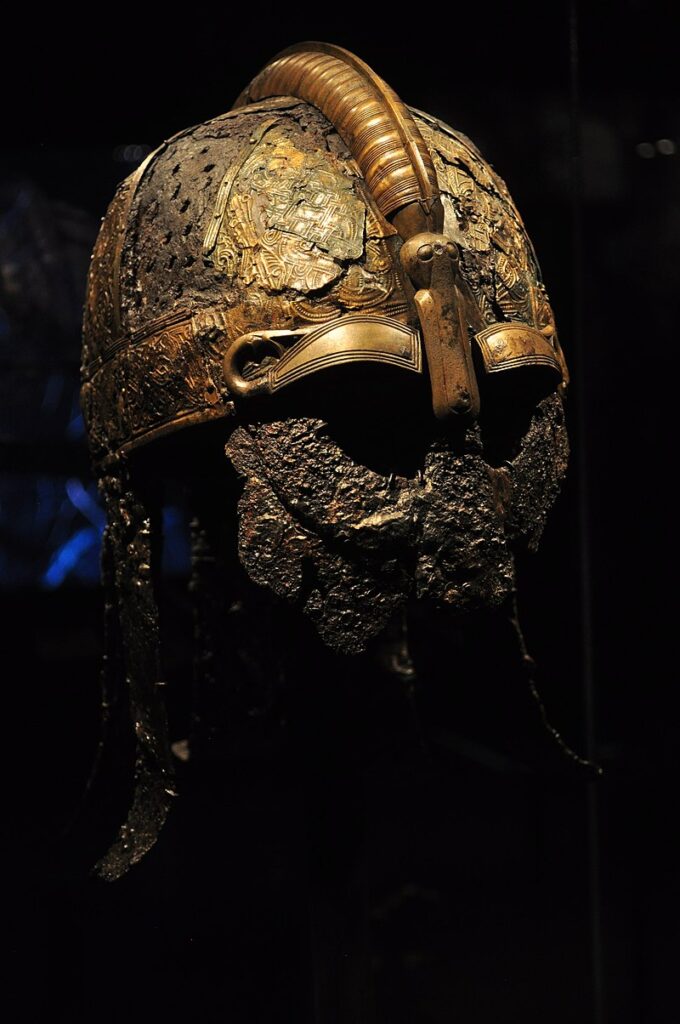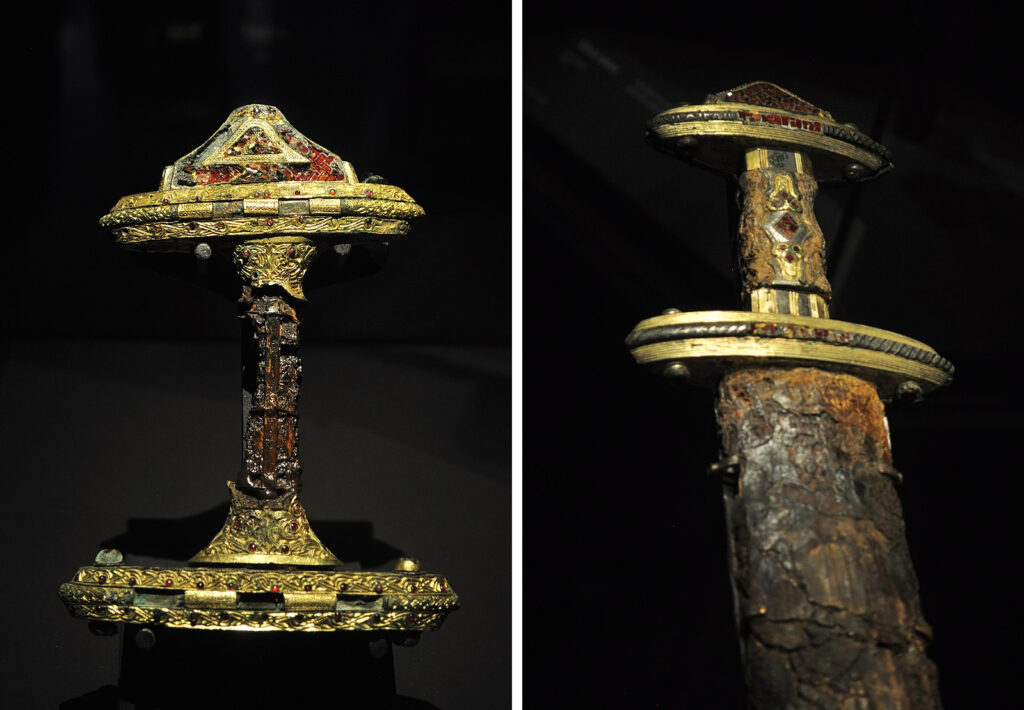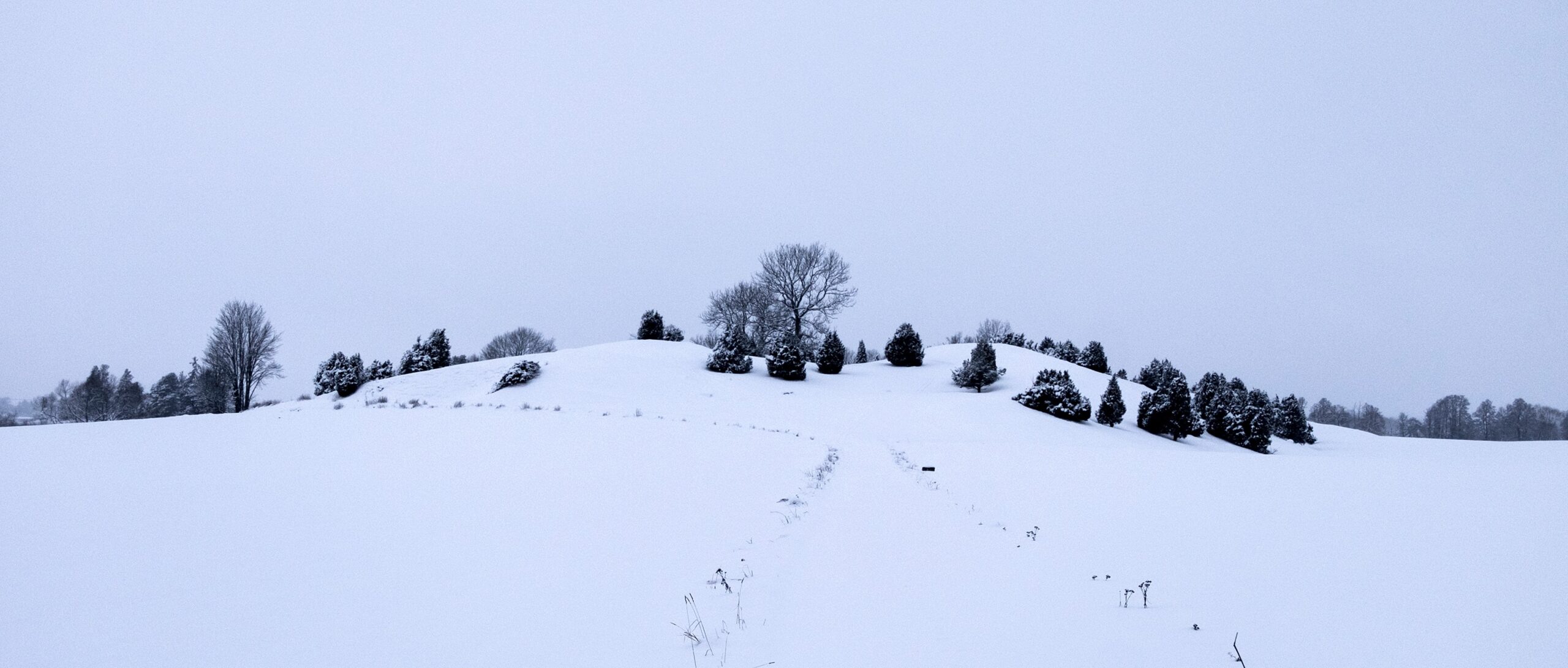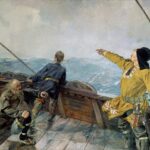The burial ground of Valsgärde, located not far from Gamla Uppsala Ian central eastern Sweden, has a history of centuries. All in all, the site features 92 graves in a variety of forms and showcasing a variety of funerary rituals. The four earliest burials at Valsgärde were placed in the 4th c. BC—during the Pre-Roman Iron Age. Centuries later, during the Migration Period (c. 375-550 AD), new graves were set at Valsgärde, this time cremations. However, it was in the Late Iron Age that it became a burial ground for some of the region’s richest and most powerful individuals, and during the Vendel Period (c. 550-750 AD) and Viking Age (c. 750-1100 AD) the site saw the vast majority of graves placed.
The site was excavated throughout the 1930s and 1950s, when the lavish grave goods of some of the burials attracted immediate attention not only for their own sake but, excitingly, for their striking similarity to the famous ship burial of Sutton Hoo, England. Of all the graves at Valsgärde, 30 are what are referred to as inhumation graves (that is, in archaeological terms, a grave where the occupant or occupants were buried unburned). Excitingly, 15 of these are boat graves, belonging to exceedingly wealthy occupants. These are vastly outnumbered by the cremation graves, however, which current estimates place at 62. However, it is the inhumation burials which have attracted the most attention and fascination through the years—in particular, the lavish boat graves of the Vendel Period.
Valsgärde is, for many reasons, one of the most interesting archaeological sites in Sweden. We cannot possibly go into every detail of the site in one article, but we hope that with this piece you will gain a basic understanding of the timeline of the site and how it fit into the changing social sphere of the Late Iron Age.
The context
To begin with, we need to establish what was going on in this region during the Vendel Period in order to understand the emergence of the site and the development of these lavish new grave forms. Valsgärde emerged into a changing world: archaeological work has uncovered a period of massive societal upheaval in Scandinavia during the early-mid 6th century AD. This upheaval had a variety of reasons—ranging from the fallout of the collapse of the Roman Empire to the catastrophic climatic anomaly in 536 AD (for more on this, see our article The Vendel Period: the Golden Age of the Norse). One of the results of this was the concentration of power and prestige in the hands of a much smaller elite, who likely took and maintained this power, at least partially, by the use of force. Powerful families set up bases from which they exercised power and influence throughout the surrounding landscape. This influence was often bought via strategic alliances formed with other, local chieftains or strongmen, leading to a complex hierarchy of—to use modern terms—overlords or “kings”, regional nobles, the nominally free people who were both their servants and their charges, and unfortunately, the unfree people who doubtless did much of the thankless manual labour that kept the society running.
One of these new centres of power was the illustrious Uppsala—specifically, what is now called Gamla (“Old”) Uppsala—in central-eastern Sweden. This soon became the ruling core of the region referred to historically as Svíþjóð (or Svealand). The ruling family here, known to historical literature as the Ynglings, constructed an enormous hall and, within the first century of their seizing power, had raised three colossal burial mounds, presumably housing rulers of the dynasty.
How, then, does Valsgärde fit into this scenario? The site is located some 2 km north of Gamla Uppsala. The Vendel Period graves at Valsgärde are elaborate indeed, and speak to people of incredible material and martial power—however, they are not generally suspected to have been “kings”. It is more likely that the wealthy warriors housed in Valsgärde’s Vendel Period boat graves were the local strongmen discussed above: they probably owned their own land, were independently wealthy, and commanded their own retinues of warriors, but ultimately owed their allegiance to the kings at Uppsala. We cannot be certain by what title these people may have gone, but if the ruler of Uppsala were to be called a “king”, then we might conceive of them as local “lords”. This being said, no hall nor settlement site has been found that can be concretely connected to Valsgärde, so it is unclear where these people lived and held influence—making it difficult to figure out exactly what role they played.
While they may not have been kings, do not lead you to underestimate their prestige, however. The contents of the boat graves at Valsgärde indicate individuals of colossal wealth. And it is to them that we now turn.
The boat graves
No fewer than 15 boat graves have been excavated at Valsgärde—a very large concentration, rivalled only by the contemporary site of Vendel with 14 boats. The boats themselves ranged between 6-15 m long but were slim-built, meant primarily for navigating rivers (contrasting with the massive ship burials of Gokstad and Oseberg in Norway, which appear to have been seaworthy). All boats were clinker-built, made of overlapping planks riveted together with iron nails. In most cases, these nails are all that remains of the boats (most of the wood having rotted away), and careful documentation of the rivets’ arrangement in the ground is what allowed archaeologists to determine their size and build.
The burial ground is situated very close to the river Fyris, a waterway which served as a crucial route of travel and communication in the region, and the suspicion is that the boats travelled along this river to Valsgärde, perhaps drawn by horses on the banks, where they were brought ashore and dragged to their final resting place. Again, however, as no settlement site has been found associated with Valsgärde, where these boat were being brought from in the first place is still a mystery.
The earliest of these graves dates to the dawn of the Vendel Period, in the late 6th c. AD. Over the next (roughly) two hundred years, five more boat graves would be placed at the site. Each grave was designed to house a single (human) occupant, laid on their back in the aft half of the boat, some on bearskins or beds of feathers. In all cases, the skeleton was fully or partially incomplete by the time the grave was excavated—this is, itself, a difficult fact to explain, as the graves show no sign of having been robbed in the past. The last of these was placed in the second half of the 8th century, after which the boat burial tradition at Valsgärde abruptly seems to have stopped. While cremation burials would continuously be placed at the site over the next several decades, it was not until some time in the first half of the 10th century that another boat burial appeared at Valsgärde—a gap of over a century, possibly a full two.
It was now the mid-Viking Age, and boat burials were back with a vengeance at Valsgärde. Between the years 900-1100 AD, nine more people would be laid to rest in boat burials at Valsgärde. Near the end of this period, boat graves and cremations both ceased for good at the site, to be replaced solely by “chamber burials”: unburnt graves cut straight into the ground, some featuring coffins.
It is frequently said that the boat graves at Valsgärde are “high status” or “elite” in character—and they certainly are. How do archaeologists determine this? To begin with, by looking at the form of the grave itself. Graves were extremely variable in the pre-Christian Scandinavian world, and in general, a grave that would have required more labour and expense to build can be seen as a sign of a wealthier family. At Gamla Uppsala, there are the colossal mounds requiring staggering manpower and quantities to material to build. At Valsgärde, there are boats. Boat burial in and of itself was an expensive form of funeral—boats such as the clinker-built vessels at Valsgärde were costly to build, and more costly still to “sacrifice”, as well as being potent symbols of practical and spiritual power in the Norse world. Thus, being laid to rest in one signalled all of these things to onlookers (and, though they could not have known it, to archaeologists 1500 years later).
But what those boats contained only furthers this image: artefacts and animals. And it is to those contents that we now turn.
The artefacts
Each boat grave at Valsgärde is unique; while they seemed to have belonged to a long-running tradition, no two graves have the exact same suite of contents or arrangements. But the major commonality shared by nearly all of these graves is the focus on martial equipment—the so-called “warrior ethos”. The pieces that have undoubtedly attracted the most attention are the weapons and armour—perhaps above all, those spectacular Vendel Period helmets.
The four earliest boat graves at the site each contained among its arsenal a spectacular helmet, each unique but in a similar “spectacled” design, covered in adornments in bronze, gold, and garnets. These helmets, along with three similar finds from another contemporary burial ground (Vendel, farther north), are among the most iconic artefacts in all of Swedish history. They are also tantalisingly similar to the famous helmet from Sutton Hoo, East Anglia, England: a grave which, while clearly distinct from those at Valsgärde, does show certain tantalising parallels. It, too, was a boat burial—or, more accurately, a ship burial, much larger than the ones we are examining here. It contained a similar sword as the ones we shall see shortly, as well as a number of decorative objects in gold and garnets, and animals. The Sutton Hoo grave was also placed in the 7th c. AD, in the middle of Valsgärde’s first run of boat burials. All in all, it is generally taken that this indicates extensive contact and trade, possibly strategic alliance, between the aristocracies of East Anglia and Svealand in this period.

Little less iconic than the helmets are some of the swords that have been found in these graves. These, too, are lavish, decorated in gold and garnets that glitter as brightly today as they did nearly 1500 years ago. Some of them feature a golden ring fixed into the pommel, the so-called “ring swords” on which so many oaths were sworn in Germanic legend. Individually, these swords and helmets were powerful symbols of authority and wealth; combined, they could turn men into legends.

Aside from these, though, the Vendel Period graves usually contained large, decorated shields, and often spears, archery equipment, axes, and long fighting knives called seaxes. Weaponry was typically gathered around the occupant in the stern of the boat. Some of the graves were also outfitted with a set of gaming pieces, and even coloured glass drinking vessels.
On the other hand, in the forward half of the boat, a variety of more mundane household items such as cauldrons, buckets, tools, and other utensils were stored. Not only were these people being sent off armed to the teeth, but they were also well-equipped not for death, but for the starting of a new life. We know precious little about the Norse conception of the afterlife in this period: fantastical stories of Valhalla, Fólkvangr, and other afterlives are first concretely attested in texts dating to the Viking Age and later. The equipment of the graves at Valsgärde, at least in the Vendel Period, more modestly suggest that the person was due to start a new existence in a world not wholly different from our own.
When boat burials resumed in the mid-Viking Age, however, the character of these burials changed remarkably. The first two boat graves of this period are exceptions to this, containing huge quantities of grave goods including sets of scales—which has been taking to indicate that the occupants of these graves were wealthy merchants. But comparatively, the rest of the Viking Age graves were quite sparse on grave goods. The most common weapons in these graves were swords, but less ornate—no gold or gemstones, simply iron. Swords, of course, were still prestige items, so they made much the same point; but the age of the ring swords was long gone. These graves might also have contained prestige objects like gaming pieces and riding gear, and perhaps a few household implements, but nothing like the massive Vendel Period equipment.
The reasons for this change are as yet a matter of debate, but given that this was one to two centuries after the end of the Vendel Period graves, it makes sense that burial customs had changed. Still, the presence of swords and boats does point to a new line of warrior elites, but ones who lived and wielded power in a much different world than those who had come centuries before. (One point by Bengt Schönbäck is that during the Viking period, a new “class” emerged, a middle class of tradesmen, and as always, the new rich want to copy the old elite, thus ship burials became more common, however, the expense of this democratization of ship burials was the they were watered down. This in combination that is seems that the Viking period got “poorer” than the Vendel period).
The animals
The final contents of these graves were animals. Animals can tell us about the status of the person they were buried alongside in two ways. Firstly, graves with more animals—and especially, more different types of animals—indicate a higher cost than graves with fewer. But certain animals were more valuable and rare than others; a grave that contained five sheep, for instance, would still likely not be as prestigious as a grave containing a single horse.
In the case of Valsgärde’s graves, however, the point is somewhat moot. Again, the specific number of animals might vary from grave to grave, but the Vendel Period graves contained veritable menageries, with horses, cattle, pigs, sheep, dogs, birds, and fish. Sometimes, only pieces of these animals were present: cattle, pigs, and sheep were usually only represented by “fleshy” parts like legs, which suggests that they had been butchered for a funerary feast and some of their meat sacrificed to the grave. Sheep were common enough animals in most levels of society, but pigs and especially cattle were much more expensive livestock and only tend to show up in high-status environments. In this case then, attending the funeral may have meant being treated to some very fine meat.
Other animals were buried intact, and these tend to be the “companion” animals: horses, dogs, and birds of prey (though it is certainly true that the people of pre-Christian Scandinavia ate horsemeat as well, all of the horses at Valsgärde were buried intact). This suggests that these animals were meant to accompany the deceased person not only in the next life, but also perhaps to escort them along the journey to the next life. To use a fantastic archaeological term, this would make them “psychopomps” guides from the world of the living to the world of the dead.
Horses were possibly the most prestigious animals of all in this world. The people of Svealand were renowned for their horses and cavalry, and the importance of horses is more than evident in these graves. Certain Vendel Period graves contained as many as four. The horses may have been the ones that pulled the boats to Valsgärde in the first place; some of them were buried with crampons on their hooves, which suggests that they needed to walk along ice in order to do so. (they can also be used to walk in mud, so the “buried in the winter statement someone once did is now questioned).
The dogs also provide an interesting hint at elite status, as the type of dogs most commonly found at Valsgärde were “sight hounds”: tall, slender, fast-running dogs used in hunting. This was an aristocratic sport, and this type of dog is only ever found in graves that exhibit other high-status qualities. Then there are the birds of prey, such as goshawks, falcons, eagles, and even owls. These, too, are markers of an elite pastime, used in the hunting of small mammals or other birds.
But in the Viking Age, the animal collections shrink just as the artefacts collections do. Many Viking Age graves contain only a single horse; others, a horse and a dog. Only one grave features a second dog. The other animals vanish almost entirely. This does not, of course, mean that by this point the locals had stopped raising sheep, pigs, or cattle; again, it probably means that times had changed in the intervening centuries, possibly including the conception of the afterlife, and it was no longer thought necessary to have so many animals. The horse and dog, however, might still have served as trusty guides along the way—even if that journey was now taking people somewhere entirely different.
An expensive funeral, a priceless memory
Added together, the sacrifice of a boat, a whole suite of weaponry, as well as a great many young and healthy livestock, amounted to what must have been an enormous expense. Of course, if it was done with a view to securing the deceased a happy and prosperous afterlife, then it may have been considered a necessary one, but it must have been felt by the family. This in itself, however, sent a message to onlookers: this family was so rich that they could absorb such an exorbitant price and still wield power. This is what archaeologists and anthropologists refer to as “conspicuous destruction”: advertising one’s fortune by publicly destroying chunks of it without, apparently, breaking a sweat. And so the burials at Valsgärde served not only to see off the dead, but to bolster the status of those they left behind.
The other effect these graves had on people was to create a cultural marker in the landscape—memories embedded in the earth. Many of the graves were visibly marked with stones, small mounds, or wooden constructions; but even those that were not still infused the land with power. This gave people a connection to their ancestors and their past (perhaps a past shrouded in myth and legend by the time of the Viking Age), and served to create a central monument for the people of the region to congregate around. In these ways, funerals and cemeteries are far more about the living than they are about the dead; they reveal how the living want to remember those they have lost, and those that came before.
The cremations
Sadly, we know rather less about the cremation graves than we do about the boat graves (why? let the reader know: combination of destroyed burial gods, and hyper focus on boat burias). The earliest were placed during the Migration Period (c. 375-550 AD), pre-dating the boats. But the vast majority of the cremation graves were placed in the same ages as the two sequences of boat graves, and also in the intervening period.
What can be said at once is that these graves show a much more diverse range of people than do the boat graves. While the boat graves have been sexed as male (through analysis of their grave goods, thus DNA analysis is being done of them all at the moment), roughly half of the cremations were of women, and many others were children. Only a minority contained male remains. Some of the women in these graves held apparently quite significant positions in society. For instance, one of the women’s graves, dating to the mid-Vendel Period, was placed at the very summit of the higher of the two peaks—set above all the graves surrounding it and topped with a mound. Grave goods such as jewellery, beads, oval brooches, and keys found in many these women’s graves also attest to their elevated status. One contained a staff with a wooden top carved in the shape of an animal’s head. Animals themselves were also common in these graves, especially dogs, but also horses and sheep.
Many of these graves were marked with small stone circles or mounds of earth. But although this might seem humbler than a lavish boat grave, to be buried at Valsgärde at all was probably seen as an honour: to share the land with some of the most illustrious people to have lived there. Location, location, location, as they say—just ask the woman buried at the highest point of the whole cemetery. Perhaps the people in the cremations were family members of the people in the boat graves? The fact is that it is only recently that the cremation graves have started to receive the close attention they deserve, and hopefully, these will reveal much about the social dynamic of their age.
End of the line
The final boat grave was set sometime in the 11th c. AD. Also in this century, and possibly early into the next, six more chamber graves were dug. The contents of some of these are not unlike the contents of the Viking Age boat burials, with weapons, horses, and dogs. This change in form might reflect the adoption of Christian burial customs in the region, as the process of conversion was well underway in Scandinavia by this stage, though the inclusion of grave goods in these show that the people of the region were not yet quite ready to let go of their old funerary traditions and embrace the new just yet. Otherwise, it might simply represent a broader change in the culture itself: though they did not conceive of it this way, the age of the Vikings was over, and from then on, power and memory would express themselves quite differently.
Text: Christopher Nichols. Copyright 2023 Scandinavian Archaeology.
Cover image: Valsgärde burial ground. Photo by Christopher Nichols.
Further reading
Arwidsson, G. 1983. Valsgärde. In: Vendel Period Studies. Transactions of the Boat-grave symposium in Stockholm, February 2-3, 1981, edited by J.P. Lamm & H-Å. Nordström. Statens Historiska Museet, Stockholm: pp. 71-82.
Clark, C. 2018. There and back again: ancestor veneration and necromancy in ship-themed Scandinavian burials. Int. J. Student Res. Archaeology, 4: 109-125.
Gräslund, A.-S. & J. Ljungkvist 2010. Valsgärde Revisited. In: Internationale Sachsensymposion 2010 Haderslev Danmark, edited by L. Boye et al. Wachholtz, Neumünster, pp. 123-139.
Norr, S. (ed.) 2008. Valsgärde Studies: The Place and its People, Past and Present. Uppsala University Department of Archaeology and Ancient History. Uppsala.
About the author
Archaeologist with a Bachelor of Arts from Simon Fraser University (Vancouver, Canada) and a Master of Arts from Uppsala University (Uppsala, Sweden). My specialisation lies in bioarchaeology broadly, with a primary focus on mammalian zooarchaeology, and a special interest in the Late Iron Age of Scandinavia (though you can occasionally catch me sniffing around Egypt as well).
In my Master research I conducted an osteological analysis of domestic dog remains from Valsgärde cemetery, Sweden. The aims were to identify the number of dogs buried at the site, reconstruct the appearance of the dogs, and identify any patterns and changes between the Vendel Period and Viking Age.
I’ve always been fascinated by the relationship between humans and animals, domestic and wild, in societies throughout the world. Through archaeology, I hope to shed light on this crucial part of our shared heritage.



